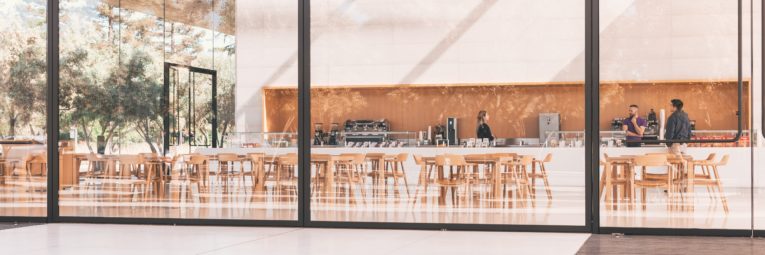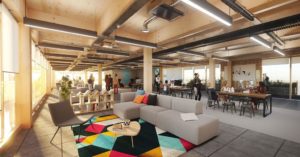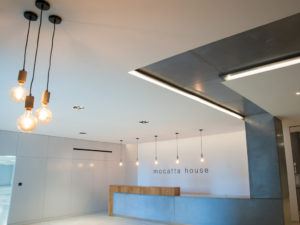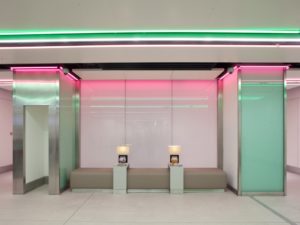
The first thing you need to know is that poor lighting in the workplace is a bigger problem than you might have thought. A research study conducted by the American Society of Interior Design shows that 68% of employees complain about the lighting in their workplace. It’s so inadequate in places that it’s giving people headaches, causing physical and mental health problems and also interfering with their sleep patterns.
Good quality lighting can solve these issues leading to better morale and improved productivity. With everyone standing to benefit, we’ve put together four steps you can take to make office lighting work harder for offices, schools, hospitals, factories, warehouses and every other workplace.
It might seem a touch ironic that a lighting manufacturer and supplier is advising you to make the best possible use of natural daylight, but it’s now evident that doing so will benefit the well-being of the workforce as well as lead to lower energy bills.

The health benefits are down to the human circadian rhythm, which is defined by the daily movement of the sun. We relied on this for many thousands of years until, some 150 years ago, the introduction of electric lighting encouraged us to move indoors away from the influence of the sun. The circadian rhythm controls the body’s release of melatonin and a range of other bodily functions to help us wake up in the morning and wind down for sleep in the evenings. The lack of exposure to daylight during the day disrupts the natural rhythm, and our bodies end up not knowing whether they’re supposed to be waking up or falling asleep.
More research published by Eco Business highlights that all this is as big a problem for employers as it is for employees. Working environments with a good level of daylight saw an increase in productivity of anything between 5 and 40%.[1]
Workspaces with abundant natural light are good for business. As well as cutting down on lighting bills, there will also be savings on heating and air conditioning.
For the modern lighting designer, it’s no longer simply a question of looking at a physical workspace and deciding how best to illuminate it.

To achieve optimum results in terms of work productivity, cost-effectiveness and sustainability, we now need to look a little deeper and ask ourselves what each different space will be used for. Work stations, conference rooms and communal areas all have different lighting requirements. These days, we think in terms of things like ambient lighting, accent lighting and task lighting, and let’s look at each of these in a little more detail.
Ambient lighting is best used in areas like the company reception, walkways, communal spaces and larger conference rooms. These areas need lighting that provides a good level of illumination to the whole area.
Accent lighting is more pinpointed, highlighting smaller meeting spaces or display areas. Here, the lighting provides sharper contrasts in the levels of brightness.
Task lighting is, as the name suggests, all down to the purpose of an individual space. Adding to the ambient lighting, task lighting will illuminate a workstation in an office or a workbench in an engineering plant. It’s a simple case of providing the necessary level of lighting to ensure each specific can be completed in comfort.
Getting all this right can help make every individual in the workforce more productive while also cutting energy bills by reducing lighting levels in areas that don’t need maximum illumination.
The colour temperature of the lighting that workers are exposed to has been shown to have an effect on their productivity. Not sure what colour temperature is?

The temperature of light is measured by the Kelvin scale and can be broken down into three levels. Higher colour temperatures of 4,600k or more are known as cool or daylight colours and they have a blue-white tinge. Mid-range colour temperatures of 3,100-4,600k give off a cool white appearance, while lower colour temperatures of less than 3,100k appear anything from red to amber white.
Bearing in mind the importance of natural daylight, as we discussed earlier, it probably won’t surprise you to hear that a dynamic change of colour temperatures throughout the day has been proven to be most effective in workspaces. This replication of natural daylight fluctuations in colour temperature has been found to decrease depression and improve mood, energy, alertness and productivity.
As with any technology, the capability and efficiency of lighting products have evolved dramatically in recent times. But the introduction of the Internet of Things (IoT) is opening up exciting new possibilities for programme workplace lighting. That means it can change subtly throughout the day to match natural sunlight and complement our human circadian rhythm.

Complementing the introduction of IoT, new smart technologies are giving us the capability to change the intensity and colour of LED lights during the day to match the appearance of natural daylight. As a result, workers, stuck inside their windowless offices, can still experience the health and well-being benefits of artificial lighting that works in harmony with our body clocks. This helps us to feel more alert, deliver higher levels of productivity and make the businesses we work for more profitable too.
The importance of the human circadian rhythm has been a recurring theme throughout this blog. We’re certain this is a term you’ll be hearing more and more of in the months ahead in relation to best practice workplace lighting, and this has inspired us to introduce our own Human Centric Lighting programme.
If you would like to find out more about our lighting solutions, please get in touch with one of our friendly experts today.
I can rely on Phi being proactive on issues arising.
Relationships & Empathy
Phi understands us, our scope and our limitations.
Relationships & Empathy
Phi delivers a good solution, which is more than just a product. Their service is good, they talk through schemes with us and there is more to it than just a catalogue.
Technical Skills
The main asset of Phi is people and the high level of technical backup they provide. For example with their competitors I meet a salesman and not a technical salesman. This difference is crucial.
Technical Skills
Good quality products at a reasonable price.
Price
Phi is not the cheapest supplier but they offer quality architectural fittings.
Price
Phi’s personal service is appreciated and differentiates them.
Service
During completed projects, we have been happy with the performance and communication from Phi. I can rely on Phi being proactive on issues arising.
Service
I see Phi for architectural led office foyers, reception areas, bespoke spaces in office blocks and good architectural lighting for commercial developments
Spaces
Appropriate for the commercial sector in particular and other places where there is a modern style requirement as befits their current product range.
Spaces
Phi is most suited to commercial offices, associated rooms and educational buildings.
Spaces
Phi delivers a good solution, which is more than just a product.
Perception & Image
We are project focused; there are lots of people in the industry but it is questionable whether they want to help and support properly. Why change to someone who may let you down, you stick with the best.
Perception & Image
Phi is not mainstream but a specialist niche architectural supplier who is a little bit different.
Perception & Image
Phi offer support, which sets them apart.
Perception & Image
Phi is a strong quality architectural supplier, giving good advice where we are lacking.
Perception & Image
Phi offer a great level of experience, supply, service and back up.
Perception & Image
I can rely on Phi being proactive on issues arising.
Relationships & Empathy
Phi understands us, our scope and our limitations.
Relationships & Empathy
Phi delivers a good solution, which is more than just a product. Their service is good, they talk through schemes with us and there is more to it than just a catalogue.
Technical Skills
The main asset of Phi is people and the high level of technical backup they provide. For example with their competitors I meet a salesman and not a technical salesman. This difference is crucial.
Technical Skills
Good quality products at a reasonable price.
Price
Phi is not the cheapest supplier but they offer quality architectural fittings.
Price
Phi’s personal service is appreciated and differentiates them.
Service
During completed projects, we have been happy with the performance and communication from Phi. I can rely on Phi being proactive on issues arising.
Service
I see Phi for architectural led office foyers, reception areas, bespoke spaces in office blocks and good architectural lighting for commercial developments
Spaces
Appropriate for the commercial sector in particular and other places where there is a modern style requirement as befits their current product range.
Spaces
Phi is most suited to commercial offices, associated rooms and educational buildings.
Spaces
Phi delivers a good solution, which is more than just a product.
Perception & Image
We are project focused; there are lots of people in the industry but it is questionable whether they want to help and support properly. Why change to someone who may let you down, you stick with the best.
Perception & Image
Phi is not mainstream but a specialist niche architectural supplier who is a little bit different.
Perception & Image
Phi offer support, which sets them apart.
Perception & Image
Phi is a strong quality architectural supplier, giving good advice where we are lacking.
Perception & Image
Phi offer a great level of experience, supply, service and back up.
Perception & Image
Phi Lighting Ltd
Unit 9, Brook Business Park, Brookhampton Lane, Kineton, CV35 0JA
Phone: +44 (0)1926 640 366Fax: +44 (0)1926 641 747Email: quotes@phi-lighting.com
Phone: +44 (0)203 875 6484
